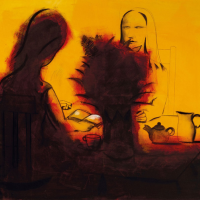17. CHARLES BLACKMAN

Charles Blackmans work is infused with an imaginative quality that while inspired by the world around him, often reflects a deeply personal and poignant response to it.
The present work depicts the artists first wife Barbara Blackman, who suffered from a degenerative eye condition that caused her to become blind in her twenties.1 Dated 1979, the artist had entered his mature phase and was painting at the height of his creative powers. This followed his early years as an artist, where during the 1950s Blackman had been a central figure within defining the movements of twentieth-century Australian art. Blackman was part of the Heide circle founded by renowned patrons John and Sunday Reed which became the epicentre of Australian modernism, and participated in the famed Antipodeans exhibition of 1959, where leading figurative artists took a stand against the dominance of abstraction in contemporary art.
Within his own oeuvre Blackman had achieved national and international success founded upon seminal series such as the Schoolgirls created between 1952 and 1955 and his Alice series of 1956 to 1959, which was based on Lewis Carrols iconic book Alices Adventures in Wonderland. This suite of over forty works also featured Barbara as the model for the surreal fantasies the artist conjured. The dislocated, phantastic quality of these paintings reflect the loss of eyesight that Barbara was experiencing at that time, as the couple grappled with their new reality.
Some twenty years later The Reading Room also features Barbara, who is here depicted bathed in light. The figure of another woman sits opposite her at the table and looks down at an open book, giving us a clue as to what transpires in the scene. The shape of this anonymous reader, along with a vase of flowers and lower half of the table merges into one area vigorously blocked-out in shades of dark brown and red. The composition is dominated by this heavy silhouette in the foreground, against an ambient golden background.
In an interesting play on the duality of light and dark, Barbara, who was no longer able to see the world is depicted illuminated, perhaps symbolic of the bright inner world this gifted poet and author continued to inhabit despite her disability. Conversely the sighted reader is painted in darkness, which serves to draw focus to the face of Barbara and the receptive state in which she as the listener appears.
This seems an appropriate portrayal of Barbara, who claims that after the initial shock and despair at losing her eyesight, her attitude completely changed for the better; I began to look more closely, not at things, but at a world closer to myself, looking from an inner space to one further within ... Immediately the substance of the universe drew together, redefined, peopled itself anew... I saw Light and went on seeing it although I was blind.2
Although Barbara and Charles Blackman divorced a year before the present work is dated, the warm sentiment the artist maintained for his first wife is apparent in The Reading Room as is his unconventional style of composition and his love of drawing. In an interview with James Gleeson in the same year, 1979, Blackman stated: I draw. That is what I love most of all.3 Created with charcoal and acrylic on canvas, Blackmans swift and sure line can be seen in the black charcoal marks that delineate this evocative interior scene.
Fusing his innovative style and poetic sensibilities, the present work typifies the originality of Blackmans oeuvre that has cemented his iconic position in the history of Australian art.
Footnotes:
1. Amadio, N., Charles Blackman, The Lost Domains, AH & AW Reed Pty Ltd, Sydney, 1980, p.44
2. Galvin, N., How Being Blind Became a Gift for Author Barbara Blackman, The Sydney Morning Herald, Sydney, 4 April 2016, accessed May 2021:
https://www.smh.com.au/entertainment/books/how-being-blind-became-a-gift-for-artist-and-author-barbara-blackman-20160404-gnxklq.html
3. Gleeson, J., Interview with Charles Blackman, 26 April 1979, National Gallery of Australia, Canberra, accessed 17 May 2021:
https://nga.gov.au/Research/Gleeson/pdf/blackman.pdf
Marguerite Brown, MA (Art Curatorship)